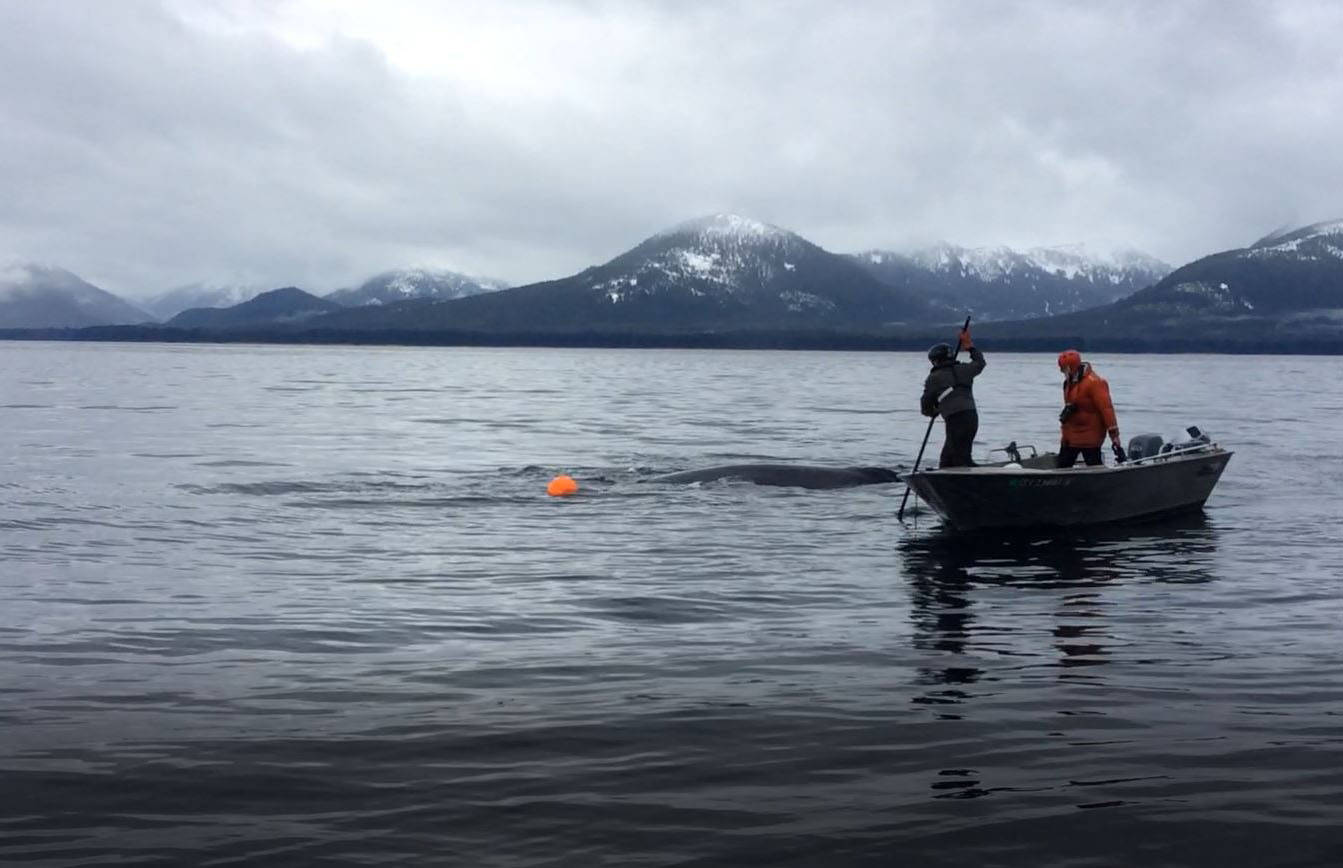While most Alaskans were preparing for Thanksgiving dinner, the residents of Tenakee Springs worked to free a whale tangled in buoys and crab pots.
“We were first alerted about this entangled whale last Wednesday,” said Julie Fair, National Ocean and Atmospheric Administration spokesperson, in a phone interview. “Apparently residents of Tenakee had heard noises from the distressed humpback whale early in the morning.”
The whale was mostly disentangled by Thursday afternoon, Fair said, with only a small buoy still entangled.
“It took some time but they were able to get a grapple hook under the line that it was tangled in and cut it. Once they cut this line, it released most of this entanglement including a crab pot, which was anchoring the whale there, and it was able to swim away,” Fair said. “It does it have a couple buoys attached. We’re hoping that gear will self-release. If people see a reddish-orange buoy with 00002, we’re hoping people will let us know.”
[State reports 2nd inmate death related to COVID-19]
The humpback had become snared in a series of buoys and a large crab pot, said Steve Lewis, a biologist for the Alaska Department of Fish & Game and certified marine mammal responder who lives in Tenakee Springs, and, along with Gordon Chew, another resident and certified rescuer, helped organize and carry out the disentanglement. In total, 19 people helped disentangle the whale from the worst of the snag, Chew said in a phone interview.
“There’s still some entanglement and gear there. The animal was hogtied when we got to it,” Chew said. “The animal was able to swim free and was making about four knots when we followed it out to the Chatham Strait.”
The animal initially became entangled late during the evening of Nov. 23, Chew said, and could be heard by multiple residents of the town in distress. While it was able to breathe, the lines it was tangled in wouldn’t allow it to unbend, effectively hogtying the great cetacean while anchoring it to the bottom with the crab pot, Lewis said.
“Whales often roll when they encounter something — not necessarily a good thing if that’s a line,” Lewis said in an email. “This whale was actually not as ‘thoroughly’ entangled as some — but it had a line in its mouth that then wrapped around the peduncle, in effect tying front to back.”
Freshening winds, fog and low light all made for a difficult rescue, Chew said. Rescuers first conferenced with NOAA marine mammal rescue specialists and performed reconnaissance around the whale, taking video of the tangled creature for experts to view, Chew said.
“In almost all instances, a slow, measured, thoughtful approach is better for both the whale and the people working around it,” Lewis said. “It’s very, very rare for an animal to be so tangled and anchored that death will occur before a careful approach can be developed — and all too common for a rushed approach to further endanger the whale.”
With a plan in hand, rescuers set out in a total of five boats to clear the entanglements on Thanksgiving morning. In a town of about 100, nearly 20 people showed up to lend a hand, even on the morning of the holiday. Both Lewis and Chew have responded to multiple entanglings and strandings before.
“Small Alaskan towns do respond to incidents with an all-hands-on-deck response in most instances. I’m sure we could have recruited more folks if the need had been there — certainly there have been emergencies where essentially every able bodied person in town responded,” Lewis said. “I don’t think Tenakee is actually unique in this, but it sure makes living in small town Alaska extra special to know that everyone has each other’s backs.”
While the rescue wasn’t a complete success, with one buoy still attached, Chew said, it had a much better chance of survival without being lashed to a heavy crab pot. NOAA was not able to identify the animal, as it never lifted its tail out of the water, Chew said.
“I think we accomplished our goals, but you could always do more. It’s hard to be the guy with the knife and not completely accomplish your goals,” Chew said. “The animal has a much greater chance of survival not being trussed up with a four hundred pound pot for an anchor.”
What do you do if you see a whale in distress?
Do not, under any circumstances, attempt to help the animal yourself, Fair said.
“Remember that these were specially trained responders,” Fair said. “Do not attempt to do this yourself. If you see a whale entangled, call our hotline.”
That hotline is 1-877-925-7773.
While most whales are able to self-recover, some require expert help that NOAA fisheries personnel are specially trained to give, Fair said.

